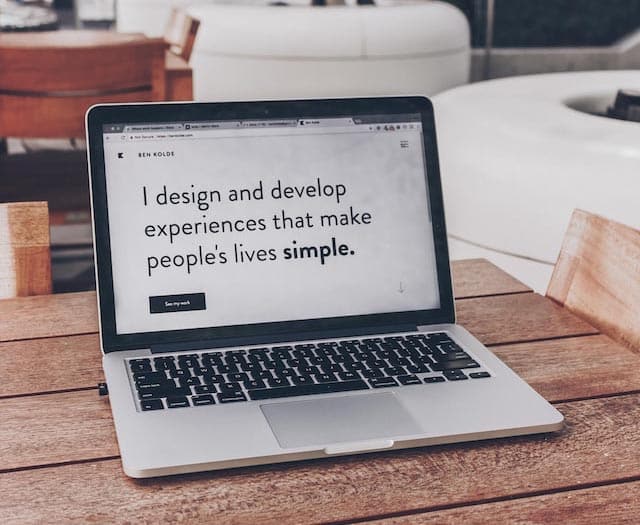Knowing how to write good website copy can be a central factor in a successful website.
Top of the list of concerns from website owners are questions like:
- How can I get more visitors to my website?
- How can I get more backlinks to grow my domain authority?
- How do I get more sales?
- How can I get more people to share on social media to spread the word?
Learning how to write good website copy can help with all these, and more besides.
Whether you're writing copy for product descriptions, pages, a blog post, an email, a social post here are some top tips on how to write good website copy.
TABLE OF CONTENTS
COPY v CONTENT
Just to clarify....
WEB COPY refers to written communication. On websites it is used to educate, inform, communicate about products or the brand, to persuade visitors to take certain action, etc.
WEB CONTENT can be written communications but it also refers to any other website content such as images, graphics, video, audio - in fact anything that appears on a website, and is part of the web design too.
Here we’ll be focusing on how to write good website copy specifically, as opposed to other web content.
THE IMPORTANCE OF GOOD WEBSITE COPY
What exactly does good web copy look like? Why does it matter? And what's the best practice?
When someone comes to your website, they are there to fulfil a need. They are trying to decide whether your product or service, or your company, can fulfil that need for them.
Your website has approximately 0.5 seconds to impress before a visitor decides to stay or to will click away. It’s brutal. But forewarned is forearmed, so bear this in mind and ensure you always use effective copy, to help increase your conversion rate.

Good copy should make it easy for visitors to understand what your business does and how they can benefit from it. It should be clear, informative, and engaging, use words which are easy to understand and communicate well.
Your website will often be the first interaction and first impression a potential customer will have with your business, so getting the copywriting right is important. It can help create trust and credibility. It sets the tone for your brand and it can determines whether someone wants to engage further and perhaps become a customer.
Different companies will have different needs for their website pages but most copywriting should consider the following points below.
DEFINE YOUR AIM
First thing before writing any web copy you need to consider what you want to achieve with the web page you are creating.
Each web page will have a different aim. Some may be purely to inform - for example to build and promote brand recognition and online presence. Others may be to sell, especially e-commerce pages. And some may be to educate - perhaps about the use of your products or more generally about your industry, perhaps to build authority and demonstrate knowledge. Consider too if an active voice or a passive voice would be more appropriate?
It also depends if it is a blog post or a business page. Blog posts are usually longer and have more scope to develop ideas whereas business pages will generally focus copywriting on presenting aspects of the business, such as the services offered.
It's important to clarify your objectives, overall for the site, but specifically for the particular page you are creating the web copy for, and set a clear goal or outcome for the page before you start.
KNOW YOUR CUSTOMERS
To create the right copy it’s crucial to know your target audience. Consider their age, sex, education, location, goals, needs, priorities, pain points, interests.
Build up a customer persona - a personality for the customer you are aiming your copy and product or service for. Knowing who you’re talking to helps tailor the message accordingly.
Write copy as though you’re talking to just that one person. Even if there will be many different people who read it (and you hope there will be!), assume that each sentence is going out to one very specific person, and have that person in your mind as you write.

How do you know who your target audience is? How can you find out what their goals are and what they need? You’ll generally have a good idea who your target audience is in broad terms but to narrow it down, consider past clients, carry out market research, visit forums like Reddit and Quora, use one of the many online services to build a buyer persona.
KEYWORDS & SEO
SEO (search engine optimisation) is the practice of optimising your website so it ranks higher in search engine page results (SERPs). SEO has many different aspects from page load speed to backlinks from other websites, but one of the most crucial aspects is using the right keywords.
Keywords in your copy indicate to search engines what the subject matter of the web page is about, so they know when it's best to show it in SERPs so that it matches what people looking for.

For each web page you need one primary and several supporting keywords to maximise results. These are placed in strategic places such as in the page title, section headings, throughout the body of your text, and so on.
Keywords are amongst the most important aspects of web copywriting but getting keyword research right is a whole big topic on its own, so can't be covered here, but check out our dedicated blog on How to Do Keyword Research to learn all you need to know.
OFFER A CLEAR VALUE PROPOSITION
Always be clear about your value as a company and that of your products or services. Highlight how you serve and benefit your customers and how you are different from the competition.
If you can’t communicate what your value is how do you expect potential customers to understand why they should buy from you?
FOCUS ON THE BENEFITS
There was a time when it was enough to simply list out the features of a product to get sales, but those days are long gone as consumers have become much more sophisticated and more spoilt for choice with almost infinite options only a few clicks away.
Talking about benefits not just features, relates what your product or service will do for a potential customer and how it will help them. It tells them what they will become if they use your product or service, not how it works, and highlights how it will change their lives for the better.

Of course you should include the features, but don’t make them front and centre. Include them in Technical Specs or a More Info tab. For some products people expect the technicalities, but not at the expense of promoting the benefits. If you've never visited the Apple website, you'll have seen it's a masterclass in selling the dream, for a product which you'd think the specs would be the biggest selling point.
Remember, people don’t buy a laptop (or whatever the product or service is) they buy the perceived benefits that the laptop gives them.
If your copy has more ‘we’ than ‘you’, then you’re focusing on features, not benefits.
Express who your customer will become once they use your product or service. Make it obvious why they should buy from you by focusing on the benefits to them. If you get stuck try to write answers to the question, ‘what’s in it for them’
BUYING A SOLUTION
The truth is that most people don’t set out to buy a product or service, they set out to buy a solution. But more than that, they set out to buy a feeling.
Consider a potential new website client, on the surface they are looking for a website to sell more products, to make their company look good, to earn more money, to have a successful company, to build the business up and so on....
But behind that is the feeling. What he is after is likely to be - the feeling of being proud of his achievements, the feeling of being relieved he’s taking good care of his family, the feeling of being happy he has a lot of options for his holidays, car, home etc.

It is never about the product itself. It’s about what the product will make someone become. It’s not about the website, it’s about the website making him feel successful, a good provider, happy, free…. and so on.
And good copy will help the visitor see and feel what he will become if he engages with your product or service.
LOGIC v EMOTION
As we've seen above, it’s emotions that are behind pretty much every decision to buy a product or service. It’s possibly driven by a perceived lack that needs to be filled or an aspiration, but behind the obvious logical reason there’s emotion driving the intent.
When logic and emotions battle out a decision, almost invariably emotion wins with the majority of people. This is due to how our brains develop and operate. How many times do we know that we really don’t need xyz, but can’t help buying it. How many times have we made pros and cons lists then completely ignored the obvious winner, because it just didn’t ‘feel right’?

Consider what your customers’ emotional goals are. What are they trying to really get from your product?
A good copywriter needs to find the right motivating emotion for the particular product and target audience, to speak to the emotion that is likely propelling the sale.
Also be aware that different industries may value the same word differently. An interesting experiment was carried out on this by Hubspot – Ways Emotions and Word Count Affect Your Landing Page.
USE IMPLICIT SIGNALS
Rather than just listing facts or spelling it out, paint an image, paint an outcome. Focus on how the customer will benefit, and use implicit language and signals.
Implicit language is when something is not specifically stated, but can be inferred from the surrounding information. It can include assumptions about the audience's knowledge and understanding, as well as cultural norms that may influence how a message is interpreted.
Implicit language is often used in company slogans or tag lines. A few great examples are:
Skittles – Taste the rainbow
iPhone X – Say hello to the future
Visa – Everywhere you want to be
Nike – Just do it!
Implicit signals can be very powerful in positioning a brand or product, as well as being an opportunity to inject some humour or light heartedness.
BACK UP CLAIMS
If you claim that people will look 30 years younger after using your product for 5 days, back it up. Use science, use testimonials, or whatever is appropriate for your particular industry, to give credence.
Including testimonials or customer reviews in your web content has a positive impact because they are perceived in the same way as if a friend had made a personal recommendation. If you can link Trustpilot or Google reviews it’s even better because it gives the impression of greater impartiality.
It’s also been found that reviews with a clean 5 out of 5 stars, is actually less trusted than reviews with 4.8 or 4.9 out of 5 stars, as people are suspicious that they might be faked.
ADDRESS CONCERNS
Your copy should anticipate prospective customers' concerns. Don’t leave a window for them to say ‘no’.
If you’re not sure about what their concerns might be, again have a look on forums to see what discussions are going on around the topic, or look on social media like Twitter and Facebook. Use these to create a Frequently Asked Questions (FAQ) page or section.
A/B TEST
An A/B test is an experiment in which two or more versions of the same copy are created and their success compared. By doing this you can find out what works and what doesn't.
Have one version up for a time, then put up a new version, only changing one thing at a time, to be able to determine what has affected any change in response.
BE CLEAR AND SUCCINCT
The most important thing is to connect with the reader. To encourage clarity:
- avoid jargon unless your copy is intended for industry experts. Most people will be quickly put off by things they don’t understand
- keep the copy simple and use short sentences that are impactful
- write as you'd talk to offer authenticity - of course don't swear or cuss. Or write in your customers voice to connect more easily
- avoid long words – short words are more easily understood by more people and they’re easier to skim read
- pitch the language level at about Year 9 for better readability and so as not to alienate any readers

MAKE IT SCANNABLE
People like to skim and scan content. Most of us don't have the time or inclination to read long essays, so make the content easily digestible.
Break up text into short paragraphs, have compelling headings, make use of subheadings, include bullet points. All these will help break up the text and make it more scannable.
Remember you only have 0.5 seconds to impress.
DON’T FORGET YOUR COMPETITION
Check out your competitors' websites for copy ideas. And create something better and more comprehensive!
Differentiate yourself from your competitors. Highlight what makes you different. It could be things like unique products or product benefits, the service element such as no quibble guarantees or free postage, price comparisons, geographical area etc.
Whatever your unique selling point is, focus on it and communicate it well.
INCLUDE FREQUENT CALLS TO ACTION (CTA)
What action do you want your website visitor to take? To buy something? To contact you? To sign up to a newsletter?
Use buttons and highlighted text to encourage action. Use direct language to tell your readers what to do next, in an encouraging rather than aggressive way. Be clear and direct.
To find the right wording, put yourself in your visitors shoes and complete the sentence ‘I want to ..…’ – for example Get A Quote, Get A Free Trial, Learn More
FINAL THOUGHTS ON HOW TO WRITE GOOD WEBSITE COPY
The website design is important as it can draw people in but knowing how to write good website copy will help you connect with your customers better, increase customer engagement and lead to more sales.
Create copy which speaks to your visitors by really understanding their needs. Write persuasively, use captivating headlines and make the page easily digestible. And of course it goes without saying, make sure you write good English!
Remember the old adage –
It’s not just a matter of convincing a potential client to buy a product, it’s a matter of convincing him to buy it from you.
Hope this has been helpful in showing how to write good website copy.
Now get to it!
How To Write Good Website Copy last updated Oct 2022



